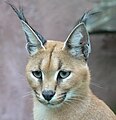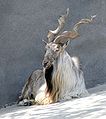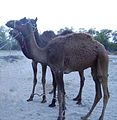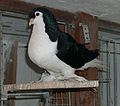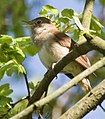پاکستان دا جنگلی جیون
| بسلسلہ مضامین |
| پاکستان دی جنگلی حیات |
|---|
 |
|
Biodiversity |
|
Organizations National
Ministry of Environment (Pakistan) · Pakistan Environmental Protection Agency · Dhodial Pheasantry · Zoological Survey Department of Pakistan · سندھ · Punjab Wildlife Department · Khyber Pakhtukhwa Wildlife Department · Baluchistan Wildlife Department · Gilgit Baltistan Wildlife Department · Himalayan Wildlife Foundation · National Institute of Oceanography (Pakistan) International |
|
Related topics |
پاکستان دے جنگلی جیون وچ سمندری ساحل توں بہت اچے علاقےآں دے پہاڑی علاقیاں وچ رہن والے وکھو وکھرے آلے دوآلے دے واسیاں وچ وکھو وکھرے جانوراں اتے جانوراں دی شمولیت شامل اے، جنہاں وچ 177 ددپلانے اتے 660 پنچھیاں دیاں قسماں شامل نیں ۔ [۱] دیس دے جیو-جنتوآں دی ایہہ ون سونی رچنا، دو پرمکھ جیوگرافیکل علاقےآں ، پلائرٹکٹک اتے اوریئینٹل دے ذریعے تبدیلی والی زون وچ اپنی جگہ نال جڑی ہوئی اے۔ [۲]
پاکستان دے جنگلی جیون وچ سمندری ساحل توں لیکے پہاڑاں وچ اچائی والے علاقیاں تک دے وکھ وکھ وسیاں وچ ونّ-سونے پودے تے جانور شامل ہندے ہن، جنہاں وچ 177 تھندھاری اتے 660 پنچھیاں دیاں قسماں شامل ہن۔ دیس دے فیونا دی ایہہ وکھ-وکھ رچنا اس دے محل وقوع دے نال غیرمستقل زون وچ دو پرمکھ وچکار متعلق اے۔[۱]
بنسپتی تے جانوراں دی رہایش
[سودھو]اتری اچے حصیاں وچ اُبھے پنجاب تے آزاد جموں کشمیر دے ہیٹھلے اچائی والے کھیتر تے اچی اچائی والے کھیتر شامل نیں جیہڑے ہمالیا، قراقرم تے ہندوکش پہاڑی سلسلےآں دیاں تلیاں نوں اپناؤندے ہن۔ ایہہ کھیتر الپائین چراؤن والیاں زمیناں، سب-ایلپائین سکربّ اتے تپشاں والے جنگلاں دے روپ وچ جنگلی جیون لئی اک ودھیا نواس حاصل کردے ہن۔ ایہ علاقے انسانی پہنچ لئی مشکل ہن، اس لئی، زیادہ تر جنگلی جیون بہتر آبادی وچ موجود ہن حالانکہ کجھ ہور کارناں کرکے خطرے وچ ہن۔ پاکستان دے اتری اچے حصے شنپھائیدار اتے رگڑ دے جنگلاں نال ہوئے ہن، جنہاں نوں بہت ساریاں تھاواں اُتے بہت گھٹ ترقی در نال گھٹا دتا گیا اے۔[۲] ایہہ بائیوم اتر مغربی ہمالیائی ایلپائین جھاڑی اتے میداناں وجوں متاثر اے۔ اتری پہاڑی علاقیاں اتے پوتھوہار پٹھار وچ پائیاں جان والیاں کجھ جنگلی جیو ذاتیاں وچ بھیرل، یورسیئن لنکس، ہمالیئن گورل، مارکو پولو بھیڈ، مارموٹ ( دیوسائی نیشنل پارک وچ ) تے پیلے گلئی مارٹین اتے چکر پارٹرج دیاں پنچھیاں، یورسیئن ایگل-آلّ شامل ہن، ہمالیئن مونال اتے ہمالیائی سنوکاک اتے ہمالیئن ٹوڈ اتے موری ہلز ڈڈو دیاں دوبھارتیاں ہن۔[۳][۴] سندھ ندی اتے اس دیاں چناب، راوی، ستلج، جہلم، بیاس دیاں کئی پوربی معاون ندیاں پنجاب دے زیادہ تر حصیاں وچ پھیلیاں ہویاں ہن۔ سندھ ندی دا میدان مغربی سندھ ول ودھدا اے اتے قبضہ کردا اے۔ میدانی علاقیاں وچ بہت سارے پھلویئل لینڈپھورم (جویں باراں، ہڑھاں دے میدان، لیویز، مینڈر اتے بلد-کمان ) ہندے نیں جیہڑے وکھ وکھ قدرتی بائیومز نوں شراکت دار کردے ہن جس وچ گرم اتے سبٹروپکل سکے تے نمی والے برینڈلپھ جنگلات دے نال نال کھنڈی تے زیری جھاڑیاں (پنجاب وچ تھل تے چولستان تے سندھ وچ تھر) بک تے ندی سسٹم نوں وی دے تعاون رپیریئن اے ۔ جیہدا سپیسیز مظاہرا ککر، شہتوت اتے ٹاہلی دے درخت نیں ۔ ندیاں دے کنارے تے تامارک جھاڑیاں وی موجود نیں ۔ مون سون موسم دی اک شاندار نظام دے نال اجیہے جغرافیائی روپ پودے اتے جانوراں دیاں قسماں دی وبھنتا لئی اک اتم ادھار حاصل کردے نیں ۔ حالانکہ، میدان انسانی طور اُتے کھیتی ٹیچیاں اتے رہتل دے ترقی لئی برابر اپیل کررہے نیں ۔اَنڈس میدان سیلاب دے میداناں نوں فصلاں اگاؤن لئی قدرتی بنسپتی توں صاف کر دتا گیا اے ۔ ایہدے نال کچھ ک قسماں خطرے وچ پے گئیاں نیں ۔
مورتاں
[سودھو]-
برفانی چیتا represents the national heritage animal of Pakistan
-
Eurasian lynx ranges in northern Pakistan
-
Caracal ranges in southern Pakistan
-
Chinkara gazelle
-
Dromedary camel is the provincial animal of Balochistan
-
Long-tailed marmot occurs in Gilgit–Baltistan
-
Ladakh pika (Kashmir region)
-
Chakoor is the national bird of Pakistan
-
Common emerald dove, common throughout the Indian subcontinent
-
Rose-ringed parakeet, a common sight in Islamabad
-
Western horned tragopan found in Azad Kashmir
-
Alexandrine parakeet occurs in the Punjab
-
MacQueen's bustard is the provincial bird of Balochistan
-
Indian cobra occurs in most of Pakistan
-
Indus Valley toad, a common national amphibian of Pakistan
-
A common butterfly
الوپ ہوئے جانور
[سودھو]مقامی طور تے الوپ ہوئے جانور:
- بھارتی گینڈا 17ویں صدی توں[۵]
- ایشیائی ہاتھی[۶]
- [ایشیائی شیر]], since the early to latest mid 19th century[۷][۸]
- ایشیائی چیتا since the late 20th century[۹]
- بنگال نائگر since the early 20th century [۱۰]
- باراسنگھا[۱۱]
- Indian wild ass since the fenced border installation at Sir Creek between India and Pakistan has restricted the species movement, thus the species being regionally extinct.[۱۲]
- کشمیری باراسنگھا (possibly extinct).[۱۳]
-
An Indian rhinoceros in Bardia National Park, Nepal
-
Prime Indian elephant habitat consists of forested areas
-
Asiatic lion in India's Gir Forest
-
Asiatic cheetah cubs with a dog in Dharwar, British India, 1897
-
Bengal tiger in Mangalore, India
-
A Southern barasingha stag in Kanha National Park, India
-
Indian wild asses in Little Rann of Kutch
-
Kashmir stag
National symbols
[سودھو]سانچہ:National Symbols of Pakistan
| Title | Symbol | Picture |
|---|---|---|
| National tree | Deodar cedar (Cedrus deodara) | 
|
| National flower | Poet's jasmine (common jasmine, Jasminum officinale) | |
| National fruit | Mango (Mangifera indica) | |
| National animal | Markhor (Capra falconeri) | 
|
| State animal | Snow leopard (Uncia uncia) | |
| National bird | Chukar partridge (Alectoris chukar) | |
| State bird | Shaheen falcon (Falco peregrinus peregrinator) | |
| National aquatic marine animal | Indus river dolphin or "Bhulan" (Platanista indicus minor) | |
| National butterfly | Indian purple emperor (Mimathyma ambica) | |
| National pet | Pakistani cat | 
|
| National fish | Mahseer (Tor putitora) | |
| National reptile | Mugger crocodile (Crocodylus palustris) | |
| National amphibian | Indus Valley toad (Bufo stomaticus) |
حوالے
[سودھو]- ↑ ۱.۰ ۱.۱ Roberts, T. (1977). Mammals of Pakistan. London and Tonbridge: Ernest Benn Limited.
- ↑ ۲.۰ ۲.۱ Shah, M. and Baig, K.J. (1999). "Threatened Species Listing in Pakistan: status, issues and prospects", Using IUCN Red List Criteria at National Level: A Regional Consultative Workshop for South and Southeast Asia, Sri Lanka. IUCN Regional Biodiversity Program, Asia, 70–81.
- ↑ Anwar, M.B., Jackson, R., Nadeem, M.S., Janečka, J.E., Hussain, S., Beg, M.A., Muhammad, G. and Qayyum, M. (2011). "Food habits of the snow leopard Panthera uncia (Schreber, 1775) in Baltistan, Northern Pakistan". European Journal of Wildlife Research 57 (57(5)): 1077–1083. doi:.
- ↑ Kabir, M., Ghoddousi, A., Awan, M.S. and Awan, M.N. (2014). "Assessment of human–leopard conflict in Machiara National Park, Azad Jammu and Kashmir, Pakistan". European Journal of Wildlife Research 60 (60(2)): 291–296. doi:.
- ↑ Talukdar, B. K.; Emslie, R.; Bist, S. S.; Choudhury, A.; Ellis, S.; Bonal, B. S.; Malakar, M. C.; Talukdar, B. N.; et al. (2008). "Rhinoceros unicornis". The IUCN Red List of Threatened Species 2008: e.T19496A8928657. doi:. http://www.iucnredlist.org/details/19496/0. Retrieved on ۱۵ جنوری ۲۰۱۸.
- ↑ Choudhury, A.; Lahiri Choudhury, D. K.; Desai, A.; Duckworth, J. W.; Easa, P. S.; Johnsingh, A. J. T.; Fernando, P.; Hedges, S.; et al. (2008). "Elephas maximus". The IUCN Red List of Threatened Species 2008: e.T7140A12828813. doi:. http://www.iucnredlist.org/details/7140/0. Retrieved on ۱۵ جنوری ۲۰۱۸.
- ↑ Kinnear, N. B. (1920). "The past and present distribution of the lion in south eastern Asia". Journal of the Bombay Natural History Society 27: 34–39. https://archive.org/stream/journalofbombayn27192022bomb#page/32/mode/2up.
- ↑ Guggisberg, C. A. W. (1975). "Lion Panthera leo (Linnaeus, 1758)", Wild Cats of the World. New York: Taplinger Publishing, 138–179. ISBN 978-0-8008-8324-9.
- ↑ Husain, T. S. (2001). Survey for the Asiatic cheetah, Acinonyx jubatus, in Balochistan province, Pakistan. Cat Action Treasury, IUCN Pakistan, Balochistan Programme. Archived 2020-04-11 at the وے بیک مشین
- ↑ (1996) Wild Cats: Status Survey and Conservation Action Plan. Gland, Switzerland: IUCN/SSC Cat Specialist Group, 17–21. ISBN 978-2-8317-0045-8.
- ↑ Duckworth, J.W.; Kumar, N.S.; Pokharel, C.P.; Sagar Baral, H.; Timmins, R. (2015). "Rucervus duvaucelii". The IUCN Red List of Threatened Species 2015: e.T4257A22167675. doi:. http://www.iucnredlist.org/details/4257/0. Retrieved on ۱۵ جنوری ۲۰۱۸.
- ↑ "Equus hemionus ssp. khur"۔ IUCN Red List of Threatened Species. Version 2017-2۔ International Union for Conservation of Nature۔ 2016
- ↑ Brook, S.M.; Donnithorne-Tait, D.; Lorenzini, R.; Lovari, S.; Masseti, M.; Pereladova, O.; Ahmad, K. (2017). "Cervus hanglu". The IUCN Red List of Threatened Species 2017: e.T4261A120733024. doi:. http://www.iucnredlist.org/details/4261/0. Retrieved on ۱۵ جنوری ۲۰۱۸.




